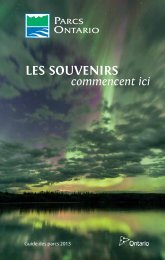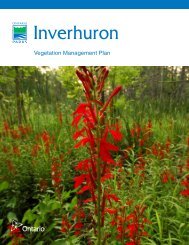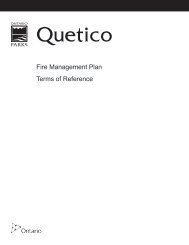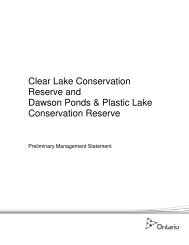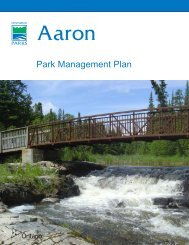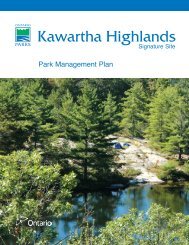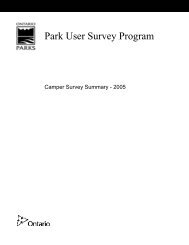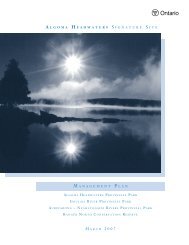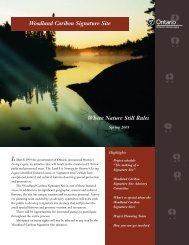Sandbanks Draft Veg Mgmt Plan - Ontario Parks
Sandbanks Draft Veg Mgmt Plan - Ontario Parks
Sandbanks Draft Veg Mgmt Plan - Ontario Parks
Create successful ePaper yourself
Turn your PDF publications into a flip-book with our unique Google optimized e-Paper software.
disturbances in accordance with the draft bulletin PM 11.03.02, Species At Risk<br />
Information Guidelines.<br />
• The NHE program should continue to include messages about vegetation<br />
stewardship<br />
3.3. Restoration Activities<br />
Due to its long history of human use, several areas of <strong>Sandbanks</strong> require restoration to<br />
enhance and protect natural features. This section deals with a range of restoration<br />
activities, listed in priority order based on urgency. Funding will be required through<br />
<strong>Ontario</strong> <strong>Parks</strong> or external agencies, but in some cases, volunteer help may be sufficient.<br />
Intensive restoration activities specific to the dunes, plantations, and agricultural lands<br />
are described in further detail in section 4.0, <strong>Veg</strong>etation Management Units and<br />
Implementation Schedules B and G.<br />
Development Zone Restoration<br />
Several areas of the Outlet campground require<br />
restoration to prevent further destruction of<br />
vegetation communities. The riparian ecosystem<br />
along the Outlet River supports many rare species<br />
and at least 3 species at risk, and the shoreline<br />
should be maintained in as natural a state as<br />
possible. Campsites along the river in Area B will be<br />
assessed, and those that are negatively affecting<br />
riparian communities will be removed and restored,<br />
as recommended in the park management plan.<br />
<strong>Veg</strong>etation destruction and<br />
erosion due to pedestrian traffic in<br />
Outlet campground.<br />
Complete vegetation destruction and erosion is apparent along the ridge between<br />
campsites 55 and 59 (see inset). The roots of several mature trees are completely<br />
exposed and at risk of damage. In order to allow this area to recover, a cedar rail fence<br />
should be constructed at the back of campsites 54 and 55, and a chipped path installed<br />
between the campsites to direct pedestrians. Native shrubs like Black and Flowering<br />
Raspberry and Prickly Gooseberry obtained from a local greenhouse supplying local<br />
native stock (Appendix C) can be planted to deflect traffic. All campsites should be<br />
monitored for similar signs of erosion and impact on<br />
the surrounding vegetation.<br />
Much of the panne habitat in the Outlet sector was<br />
lost when the parking lots were constructed.<br />
However, some panne communities and species<br />
remain in isolated areas beside the parking lots and<br />
road. These communities and species are currently<br />
threatened by excessive mowing, uncontrolled<br />
pedestrian traffic, and invasion by Scots Pine. Scots<br />
Pine should be removed from these areas and a fence<br />
erected immediately to protect the most intact panne<br />
remnant panne habitat near<br />
parking lots in Outlet sector<br />
areas. Highly degraded panne areas are good candidates for educational restoration<br />
projects, where mowing and trampling are limited.<br />
<strong>Sandbanks</strong> <strong>Veg</strong>etation Management <strong>Plan</strong> 19 of 28<br />
<strong>Ontario</strong> <strong>Parks</strong>, SE Zone<br />
2009



